CLAVIA Nord Modular G2 / G2x Synthesizer
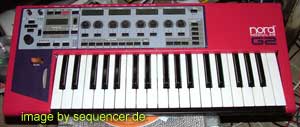
the G2 main section..
go to the quick G2 info section..
DETAILS and WHATS INSIDE
interesting new features:
1)audio can be transported/piped to another slot
2) audio range is higher now (filter 20khz instead of 15.6k)
3) there is an expansion
4) should look the way like on sweetwater / the german keyboards mag recent 2003 issue..
5) fm sound better and a bit different..
6) sequencer can run backwards now
7) not doubled but 170-180% speed..
dimensions: 68 cm wide by 35 cm depth by 11cm high
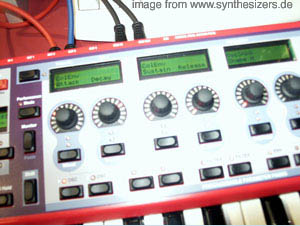
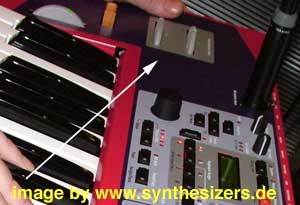
warning: this section contains opinions that are not necessarly from clavia! so if you read comments and things about "what could be" be carefull! but:
the pure info is true ;) especially the sampler rumours are NOT official!! - this is a rumours page!
THE G2 Modular Synthesizer info
this is info from the code404 list
_______________________________________________
Nord-Modular mailing list
Nord-Modular@code404.com
http://code404.com/mailman/listinfo/nord-modular
on code404.com
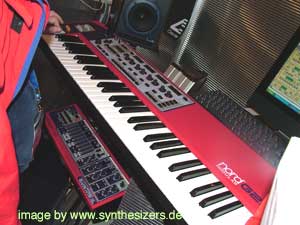
the g2x - larger and only available voice expanded plus 2 mod wheels
NOTE: the code404 list has moved to electro-music.com now!
_______________________________________________
There was a one hour demonstration of the G2 at the conference and severalmore hotelroom demo's for interested people. The state of affairs is that
the hardware is virtually fixed now, so production is expected to start
pretty soon. Software is also approaching the finish. So, as it looks
November might very well be the month of it's release.
The G2 on show in London is an alpha machine. The final G2 hardware deviates
a little from this particular alpha, but the looks are about what the final
hardware will be. In fact the London G2 is the very same machine that is
photographed in the german Keyboard Magazine September issue.
The G2 can sound slightly more brilliant than the classic NM, due to the
24-bit 96kHz DAC's and the fact that the filter ranges are lifted to a
maximum cutoff just above 20kHz (versus 15.6kHz in the classic NM). But this
is an extension of the sonic range over the classic NM, so with the proper
patching it can sound very warm and lushy.
There is a lot of changes in the oscillators, more and variable waveforms
and a slightly different approach to FM. Meaning that the sonic range has
increased considerably, as many things that happen in a filter depend on
what is actually fed into the filter. In general it is still the 'Clavia
sound', but the extended possibilities certainly add new dimensions to what
can be named the 'Clavia sound'. Sound is of course subjective to personal
taste, however it is surprising how many more possibilities there are to
tweak the sound to one's personal taste on the G2.
A one hour demo is not at all enough to show all the differences between the
classic NM and the G2, in fact I estimate it would take some eight hours to
cover all the changes. This just as an indication that we are really talking
'New Generation' here. There seem to be improvements on just about any level
and many subjects have new approaches. An example is the mixer section: all
but one mixers are by default blue, but connecting an audio rate signal to
one of the inputs turns them instantly into red signal mixers. The same for
logic modules, the yellow signals can turn into orange signals to have the
logic module work at 96kHz. This is also for the sequencer modules, they can
now be run at audio speed and some even allow for a smooth fade between
steps. Go figure!
The DSP chips run almost twice as fast (187.5% faster to be exact), but some
of this extra power is used to add some extra internal features. This means
that in practice the G2 has an estimated power of about 170% the power of a
classic NM. News is that there is an expansion connector on the mainboard
that should allow for a future DSP expansion board. (Tada!)
There is a huge amount of new features, both in modules and on the human
interface level (Play the thing, Sam!). But some software features are still
subject to change, so you have to wait a little more for the rest...
But one thing is for sure, the G2 is definitely _no_ vaporware, it is coming
and coming soon. And it is a significant step forwards.
The key model is definitely sexy, but actually I think that the engine rack
will also be a big success. Just think that for the price of something like
one third more than what most of us have paid for a Micro Modular you can
soon have a machine that is more than six times more powerful as the Micro,
features four slots for four midi channels, features a four channel
interslot audio buss, features the control of slots from other slots through
an internal interslot midibuss, features sending midi generated from within
a patch to the outside world, features freely patchable reverb and delay
effects, features four crystal clear audio inputs and outputs, features
delaylines that track the keyboard, features ..., features ..., etc. No
matter what you can come up with that it doesn't feature, we're talking
'bout a regular wild beast here.
Cause that is what the G2 is: slick and sexy looks outside but pure raw
power inside. At this moment you don't know yet what you're missing, but
wait till you have one... ;-)
_______________________________________________
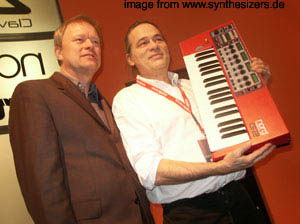
..about G2 sequencers,
playing back and forth..
thanks to @ NM list!!!
______________________
"The sequencer modules in the London G2 software version are still subject
to change." So, a final word about them can not be spoken yet.
But what is there right now are modules that are based on the classic NM
sequencer modules, plus a 'voltage' sequencer which actually behaves like a
lookup table. The voltage sequencer is not clocked by a clock but it has a
blue 'selector' input instead. The momentary value of the signal on that
input defines the position in the pattern, in other words the current step
that routes its value to the output of the module. So, if you put a lfo
sawtooth on that blue input it will step just like a normal sequencer, but
if a triangle waveform is connected it will step back and forth. Mixing lfo
waveforms before they are sent to the blue input will make the module step
in all sorts of patterns, I think the wavewrapper will also come in handy
here.
Then there is this nifty new 'Track & Hold' module that can pass the input
on to the output when the gate is high, or block the input but hold the last
output value when the gate gets low. This seems the perfect module to start
and stop the patterns on the voltage sequencer by routing the controlling
lfo signal through this module.
Another new module is the 'eight input to one output' controllable switch,
also named a demultiplexer or demux. This module can take the outputs of
eight sequencer modules while a ninth sequencer module or lfo or wildly
modulated lfo switches from which sequencer module the output will come. By
clocking the selection input with a sample & hold module which is clocked by
a master clock all can be put nicely in sync. So, this is a way to not only
A/B switch a pattern but actually A/B/C/D/E/F/G/H switch a pattern. Note
that the voltage sequencer and this demux module are related, the one being
a bit like a nephew of the other, as both work with a selector input that
works in the same way.
There are some park and chain inputs on the sequencer modules that should
allow for easy chaining, much easier than on the classic NM. Together with
the demux it should allow for the creation of long and complex patterns. I
have no idea about the limits or the number of sequences, four parallel 64
step patterns that could be A/B/C/D's did work with no problem at all.
The variation buttons on the panel can be used to instantly switch to new
patterns and knobsettings. A variation is a bit like a snapshot, it stores
all the knobvalues in a patch, including the knobs, and so patterns, in the
sequencer modules. Pressing a variation button will instantly recall its
corresponding knobsettings and so new patterns for the sequencer modules,
the S&H again being an important module to get all changes synchronized to
the G2 or midi masterclock.
And real fun is to combine the slot arpeggiators with sequencer modules. The
arpeggiators in the London software version have relatively simple patterns:
up, down, up/down or random. However..., by combining them with sequencer
modules the arpeggiator patterns can be tossed around in an almost endless
amount of variations. The simplest idea is to put S&H modules on the
keyboard CV and gate signals and clock them by a gate sequencer, the pattern
of the gate sequencer will define the arpeggio pattern. But by additionally
combining the sampled CV's and gates with CV pattern sequencers, compare
modules with more S&H's and switches, the keyboard split module, logic
modules, the voltage sequencer, the mux and demux modules, the new walking
ring counter and binary counter, switch modules controlled by panel knobs,
etc. etc., only the imagination seems the limit on what one can do. And by
setting the polyphony to more voices additional effects like chord stabs
etc. can easily be created.
The idea behind choosing for separate modules that hold a single pattern or
a module that could hold several patterns is that by keeping the patterns
'discrete' there are more possibilities, which can be patched by oneself.
One is not depending on the 'few' functions that would be present in that
one 'multi-pattern' module. It will certainly take more time to figure out
how all the possible variations have to be patched, but the freedom is much
bigger. It is my impression that the G2 is a big leap forward in this area.
It does not provide for 'off the shelf' patterns, like the MC-303 type
yammie and korg beatboxes, but hey, that's why one would want to use a G2,
right? Now one can figure out a totally personal way of playing and chopping
patterns and control them by the G2 panel knobs and buttons. I think there
is enough to keep a lot of you (and me) busy for quite some time. E.g. it
shouldn't be that difficult to patch 'Cellular Automata' or 'Markov-type'
pattern variations based on statistics that are stored in an array of
voltage sequencer/lookup table modules where the output chooses the next
sequencer to take the note or pattern from. Etc., etc...
And the note and modulation outputs can be used to be sent out on midi out
to either the other slots with the actual drumkit or synth, or to an
external midi device. A couple of months ago I considered dumping my Alesis
DMPro, but now I'm glad I didn't. :-)
So, how's your sanity right now? ;-)
Ideas and basics on the G2 hardware
possible thoughts and stuff..
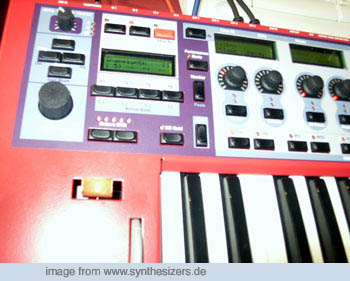
___________
> > and granular synthesis.
>
> Well, a graintable module like the Malström would be nice, and that fits
> completely with the concept! No HD required or anything.
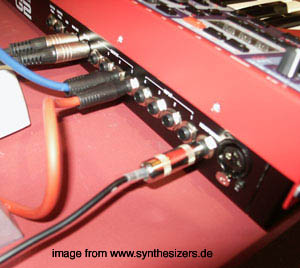 >
>
Yep, that's the idea. The RAM can be used as a buffer holding the last two
seconds or so and all sorts of functions can be executed on the material
while getting it out from that buffer. I heard there is a whole list of
sketches for possible modules based on this principle. All in all they have
enough ideas to keep the development team busy for some three years or so
(their estimate). So I don't think Clavia lacks ideas. ;-)
And that is the thing, they do have the ideas, they do have the knowledge to
implement it, they now do have new hardware with a new OS that can do it,
but they need time to actually implement it all. It is not that when one has
the idea it is also directly implemented.
>From what I understand Clavia is now preparing for the G2 release to be in
November. The module set for this first release roughly holds:
Classic NM-type audio in and outputs, plus a new four channel interslot
audio communication buss
Classic NM-type note CV processors, plus an extra pitch tracker
A redesigned set of oscillators with many extra's, like modulatable variable
waveforms, simpler FM, etc.
A redesigned set of LFO's, also with modulatable variable waveforms
A whole bunch of new envelope modules
The classic NM-type waveshapers (overdrive, wrapper, etc.)
Basically the classic NM-type filters, but some with extra features and some
new types added
A new concept for mixers, with many new types added
A new concept for switches, with many new controllable types added
Classic NM-type modules operating on levels (gain controller, amplifier,
level shifter, etc.)
A new concept for modules that operate on gate signals (logic) with several
new types of counters
A new concept for short tuneable audio delays or waveguides as used in
physical modelling, plus a plain vanilla KS oscillator
A redesigned set of step sequencers that can now also run at audio speed,
some with fades between the steps
The Classic NM-type audio effects plus a reverb and a Bode-type spectrum
shifter
The Classic NM-type drum module
A new concept for Midi-Out modules, to control both the outside world and/or
the other slots by midi generated or processed within a patch
Added to this are:
Dynamic compilation, many inputs only use DSP power if they are actually
connected
Blue modules turn to red modules when a red signal is applied to one of
their inputs
A new orange signal type to use yellow signals at a 96kHz sample rate when a
red output is connected to a yellow input
Dropdown module lists in modules, used to instantly change e.g. a Multimode
filter into a 24dB Nord filter, with automatic reconnection of patchcables
and keeping equivalent settings like cutoff, resonance, etc.
Additionally there is new on the hardware:
A global master clock with knob and display on the panel
A dedicated arpeggiator for each slot, all clocked by the global master
clock
Eight variations or 'knob snapshots' that save in the patch itself and
recallable by a panel button
A pitchstick, a modulation wheel and a linear aftertouch keyboard with a
nice tactile transition when it goes into the aftertouch area
Ledcollared knobs with dedicated displays and grouping buttons which allow
for 120 knob assignments per patch
Enhanced patch store system with possible sorting on 'genre' like bass,
brass, etc.
And whatever more that I forget or don't know about yet...
To give an idea of how much this actually is in practice, the time needed to
demonstrate all the differences between the G2 and the classic NM to a
seasoned NM user is estimated to about eight hours!
The obvious subjects Clavia will work upon for a first OS update are modules
that operate on RAM audio buffers, some more oscillator and filter types and
some more distorters and efx.
Conclusion is that a lot of _possible_ new modules will not yet be in the
first release. Simply because lack of time. But already there will be so
much more than on the classic NM that release imho is certainly justified.
That is what the London G2 definitely proved. Even if Clavia would make no
future updates, the G2 as it is to be released soon is still an incredible
powerful machine and a big step forward from the classic NM. It is
definitely second to none to any other VA synthesizer on the market. And the
rack engine is really a bargain.
Personally I think that it is a good thing that the G2 in a way still
specializes in modular VA, as trying to design it as a machine that can do
it all would also include the risks of becoming either a "Jack of all trades
but master of none", or become totally unaffordable or just stay on the
drawingboard forever.
Ok, am I biased? Not really actually, as there are and have been lots of
other 'great tools'. Being able to work for a while with this London G2
totally convinced me that the G2 will very quickly find its place between
the relatively few 'great tools' that are also affordable for the musician.
And stay there for quite a while. There is the inevitable learning curve for
a newcomer if you want to learn to patch yourself, but it is less steep than
e.g. the learning curve for a violin. A classic NM user will get it right
away, you will spend a couple of nights to check it all out, and those are
some fine hours, have your stroopwafels ready... ;-)
I think I have said about all I can say about the G2 right now, so now I
shut up for a while until it is in the shops. :-)
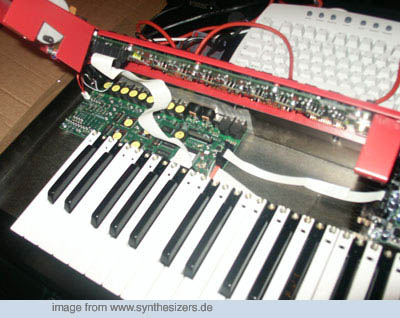
the first info about the G2 as "summary"..
quick info from nord list:
At that particular moment, I think, was running a noodly thing based upon
delay lines. If I wouldn't have been convinced of buying the machine already,
this demo certainly would have.
Unfortunately I don't have the time to really comment on it right now, but
let me say a few things nevertheless from my perspective.
There are quite a few things I'm really looking forward to to explore for
making noodles. The audio and midi routing between slots will enable me to
build huge monster noodles.
Quite interesting signals were coming from the new LFO modules (wave
transformations from sine to saw, bifurcation, etc.).
The logic modules look good, and of course there are the new possibilities
from the (de) multiplexer.
The sequencers were not the final ones, but there now will be a sequencer
that can run in both directions (actually it's more like a lookup table, like
the table module in my MidiMod program).
Sound wise I can only say that we were very happy with the new oscillators -
this says enough, I think :-)
Maybe a little drawback to me is the disappearance of the grey signals - when
I tried to make a noodle on the G2 it felt like having two left hands only
(I'm a right handed person), but I'm sure I will find my way around this. And
maybe this will lead me into some new directions, so actually it could very
well turn out to be a good thing.
Another good thing to hear was that there will be an expansion board.
Now this was an alpha version of the synth, so things are still very much
subject to change, but it all looks very promising to me, and I'm really
looking forward to having one.
NM list@code404.com
why no sampling? or: some thought what's it about..
There is 256k of 24-bit words RAM on each DSP. When the RAM is used at 96kHzit means that each slot has a total of about 2.5 sec available. When this
RAM is used in the CVA, which is the typical place for an echo delay line,
and the slots are chained through the interslot bus, a maximum delay time of
about 10 seconds could be achieved at 96kHz samplerate.
However, when the RAM is used in a voice the RAM has to be shared by the
voices, which would reduce delay time quickly. In practice there are not
many instances where one would use separate echo delays in separate voices,
the only use is in feedback loops. In all other instances the voices can
actually use one single delay line, as a delay line has no problem handling
polyphonic sounds.
E.g. when using a long delay line in a FM feedback loop the thing quickly
goes into chaotic behaviour. It is already difficult to keep control over
such a patch if it is used monophonically, when using it polyphonically it
generally goes into havoc quickly, due to the long delays. Getting it back
into something nice is as difficult as playing several saxophones at once.
The point with such patches is that it takes some time before the effect of
a tweak is heard, as it has to pass the delay line first before it becomes
audible. It is like playing something with a latency of up to 2.5 seconds.
-
There are two reasons why there is no sampling in the G2. The first reason
is that there has to be a storage device in the G2 to store the sample
files. A harddisk means that there should be a harddisk operating system
built in. The same for memorycards, etc. It would actually add a lot to the
price, and as there are already so many samplers out there it is a very
debatable option. The second reason has to do with redundancy, when a
polyphonic patch playing a sample has to be spread over two DSP's due to the
number of voices, the sample would have to be loaded in boths DSP's memory.
So, in that case the sample would present twice in the machine. It is the
thing that happens in the Capybara, that is why that machine needs a lot of
memory, adding much to its price. But this memory is not used efficiently.
So, to overcome that it would be better to use an extra DSP that does only
polyphonic sample oscillators and would distribute the outputs to the other
DSP's. But such a scheme would also dramatically raise the price of the
machine and would have several repercussions on how the DSPs communicate
with each other.
So, for sampling one would need an extra DSP with lots and lots of RAM for
those multisampled, multilayered grand piano samples people would expect,
and a mass storage device to store these samples. Additionally the OS should
be expanded to handle the mass storage device.
The G2 concept looks more like it is based on the following lines of
thought:
There are basically two different approaches in sampling. First approach is
polyphonic sampling where for each key/keygroup there are samples. In this
case sampling is used to emulate a traditional musical instrument. The
second approach is loop sampling, a snippet of sound is looped and on this
loop processing can be applied. The loop can already contain a drumloop, a
riff, or whatever. The stuff that many of us do. For this one doesn't really
need an extra DSP to do the polyphonic sampling as the loop is in general
used monophonically. But one still would need a mass storage device. The
first approach is out of the question for reasons mentioned earlier, but the
second approach is not so unrealistic in the current G2 approach.
Apparently Clavia (who is very aware of all these options) has chosen not to
include a mass storage device but instead expand the number of audio inputs
and increase the quality of the AD converters on the inputs. The idea being
this is that an external sampler can be used to provide the loops and they
can be processed through the G2 audio inputs. The point really being that,
as they said to me; "We can build a machine that really does everything, but
no one would be able to afford it. The main purpose of the RAM is to provide
for effects that need a longer time delay and modules that need RAM to do
sound generation, like physical modelling type of synthesis. But no sampling
and also no Fourier based techniques, for the moment only time domain
processing. This also has to do with the patchfile format."
So, for loop sampling one either needs an extra sampler that can still be
controlled from the G2 from its new midi out modules and then be routed into
the audio inputs for further processing. Or one can capture audio live into
a looping delay line and do the processing on the live captured loop. Both
techniques are easily possible on the G2 and are powerful enough to be of
interest. And choosing for this concept keeps the pricetag just in the
affordable range and patchfiles shareable over the Internet.
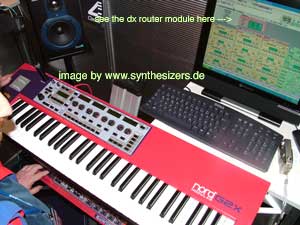 <-- enlarge the g2x modular? click the image
<-- enlarge the g2x modular? click the imagesee the first shot of dx algo ;)
you hadn't had enough? ok proceed to rob's Nord/G2 page or zevvsynth..
more info on synthesizerforum.de
(deleted older links to the synthesizerforum, just post and ask!!)
